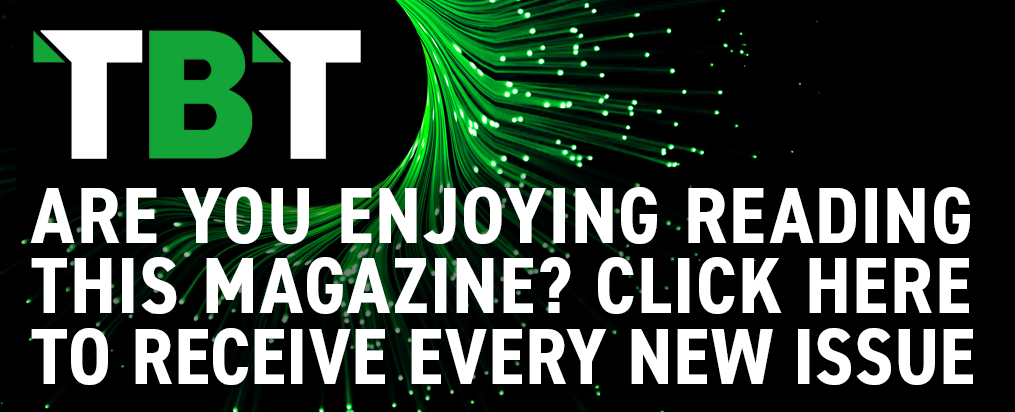AT THE EDGE OF OPPORTUNITY
Image credit: © WrightStudio - stock.adobe.com
We’re all aware of the Internet of Things and the power of the edge but how does that potential translate into revenues?
Of all the buzzwords in the IT industry the Internet of Things has to be one of the most popular.
Up there with artificial intelligence and big data, IoT is one of the most over used terms you’ll come across however, that overuse may be justified with the number of use cases at our disposal.
If you’re looking for a definition, according to HPE fellow Colin I’Anson the Internet of Things “is where the physical world touches the virtual world” as those connected devices reach the edge of networks, adding that “IoT is a part of the digitization story going on in all the industries.”
Such computing has now run through its infancy and will blossom into an industry with total revenues just shy of $100bn by 2023 in APAC alone according to Global Data research.
Back on the ground Kevin Maher, UK & I Country Director for Sigfox, stressed the importance of a “balance between deploying the lowest number of sensors and extracting the most meaningful data possible” when deploying a solution.
“There are multiple different ways of getting data from a sensor back to an application platform but at the end of the day, you need to get the most info-data, not just every single piece of data you can get.
So the role that the edge devices play, not only processing data at the device level but then deciding which is the right information to send back to you, means that you're getting more effective use of that data and you’re not spending huge amounts of resources on getting that data that you don’t need and will never use.”

“The rewards are potentially great - customers buying IoT solutions are fiercely loyal to their suppliers due to the reliance on their expertise and the hand-holding through the early phases of an IoT deployment, and when business cases and ROI are proven, the expansions on the cards are much larger than a typical Telco-deal.”
NICK SACKE – HEAD OF IOT AND PRODUCTS, COMMS365
Head of Sales, Marketing and Operations at Dynabook Northern Europe, Nick Offin said that such data crunching will continue to be carried out in the cloud, which is where, as Maher alluded to, the value of edge computing can be found.
“Cloud will remain a key topic of interest for channel players and with this comes a growing focus on edge computing. As businesses look to implement emerging technologies such as IoT, big data analytics and AI into their businesses, edge computing will only continue to gather pace, and many will continue to turn to channel partners to support increasing migration from traditional infrastructure to the edge.
The value of edge computing comes in its ability to provide secure and powerful computing at the periphery of the network, reducing operational strain and latency. In 2020 and beyond, mobile edge computing will act as the gateway for even more IoT solutions to be used across the channel. In the same way that laptops and smartphones created a new environment for office workers, mobile edge computing will do the same for workers.”
The potential of IoT is really felt when truly mobile. Low powered, small data interactions that Maher is referring to can come in the form of underground sensors in crops for example, to monitor soil nutrient levels and optimise the best time to perform certain jobs.
One enabler of such systems is the launch of 5G earlier this year. Certain bands of spectrum, around the 700Mhz mark, may not be able to deliver the gigabit speeds needed to live stream the Westlife reunion to your friends, however it can cover further than other wavelengths allowing for these low data use cases.
“It’s estimated that 59 percent of IoT data will be processed (in some form) by edge computing by 2025, so we’ll see an explosion of IoT edge aggregation hubs” said Nick Earle, Chairman and CEO of Eseye. “This means that smart equipment will communicate over protocols like Bluetooth to custom edge devices, which will do local processing and backhaul the metadata over cellular to the corporate applications.
Additionally, the introduction of 5G will create a huge number of new use cases around Augmented Reality (AR) and Virtual Reality (VR) for the channel. As an example, imagine being able to hold up a custom tablet in front of complex equipment and seeing a 3D view of the bill of materials of all the components and sensor information.
This will allow the maintenance engineer to diagnose the resolution immediately without having to take things apart. And remember that maintenance engineer could be 500 miles away in the factory, hence the opportunity around cellular backhaul.”
“The rise of 5G and edge computing is helping organisations within emergency services resolve potential issues” added Offin.
“Edge computing helps organisations to resolve challenges, while at the same time enabling new methods of gathering, analysing and redistributing data and derived intelligence. Processing data at the edge reduces strain on the cloud so users can be more selective of the data they send to the network core.”
However, according to I’Anson, 5G is not the only enabling connectivity protocol and, in fact, technologies such as WiFi 6 and 4G have their upsides, adding that all three have “a major role” to play in the future uses of IoT.

“The next release of 5G coming out the standards body, called R16, in spring next year includes the narrowband capability that is really useful for IoT. The nature of that narrowband technology is that it is super low power, fairly high range, meaning it's much easier for people to deploy and it has the potential to enable the remote device to have a battery life of 10 years.”
COLIN I’ANSON – HPE FELLOW
“There are lots of people deployed across existing Wi Fi deployments, and there are many things you can do. Wi Fi 6 is going to be very important in the extra capacity it is going to give us in environments and 5G is going to be utterly important, but that doesn't become available to us until around 2021- 2022.
The next release of 5G coming out the standards body, called R16, in spring next year includes the narrowband capability that is really useful for IoT. The nature of that narrowband technology is that it is super low power, fairly high range, meaning it's much easier for people to deploy and it has the potential to enable the remote device to have a battery life of 10 years.
So, as operators begin to make this low power 5G variant available, that's going to accelerate loads of people's capability. At that moment, of course, the telecom providers get themselves into a very strong position and they become one of the partners that people like ourselves, a value added resellers, and everybody has to be working with because they hold a key part of the system.”
Now that the technology is here, in theory anyway, the key question on a lot of lips will be how should the channel position a solution for enterprises?
Offin said that IoT is a particularly interesting play because it is a horizontal technology, adding, “Industries with a heavy reliance on frontline and field workers – such as logistics, manufacturing, warehousing and healthcare – are increasingly adopting solutions like assisted reality (AR) smart glasses.
One such industry is the emergency services sector. Decision-makers within the police, fire and ambulance services are beginning to recognise how they can best use these devices to enhance the mobile productivity of workforces, improve first-responder safety and better patient care.
We’re currently on the cusp of seeing these use-cases become a reality. However, as with all new technology, there are problems to iron out during initial experimentation phases. Considerations must be taken around the user-friendliness of equipment, including whether devices are lightweight, robust and reliable enough for use on the frontline.”
Earle agreed with the horizontal thesis. He said “When you look at previous market shifts, like client-server, PCs and Cloud, they were all driven by sets of industry vertical application opportunities. My experiences of IoT at Eseye and Cisco, have shown me that it’s an entirely horizontal proposition with the potential to transform a plethora of business processes across a whole host of industries.
“That is because no previous IT-enabled innovation has enabled the deconstruction and reconstruction of essential business processes like IoT has. For example, for the first time enterprises can transform their global supply chains to eliminate waste and delay, turn reactive people-based maintenance into software-driven proactive and pre-emptive maintenance and turn all physical products into a personalised experience. When you look at it this way IoT has the power to completely disrupt a whole host of sectors.”
However, despite the “plethora” of opportunities, resellers have seemed shy to come to market. Earle explained this is because systems are complicated and resellers have to carve out a niche to specialise in to deliver a solution.
“The challenge for channel partners, with their limited resources, is to pick the right partners who can deliver near zero-touch solutions so that they don’t have to invest in lots of people to patch it all together.”

“My experiences of IoT at Eseye and Cisco, have shown me that it’s an entirely horizontal proposition with the potential to transform a plethora of business processes across a whole host of industries. No previous IT-enabled innovation has enabled the deconstruction and reconstruction of essential business processes like IoT has.”
NICK EARLE – CHAIRMAN AND CEO, ESEYE
Peter Ruffley, chairman of Zizo added “The problem here lies in the ability to sell the whole package of IoT. IoT specialists are able to get to the value quicker, as many organisations struggle to see quick wins with IoT.
This is due to the heavy investment in hardware and software to bring a platform to the customer. Many organisations with a broad sweep of technologies can find themselves focussing on the area of the solution with the biggest margin, as opposed to the one that brings best value to the customers.”
Nick Sacke, Head of IoT and Products at Comms365 adds that further education is needed for the Channel to really grasp the opportunity for growth that is in front of them. The main challenge facing channel partners is to become educated on the elements that make up the value chain and how they work together as a solution to deliver the end result, i.e. data and insight to customers.
This represents a steep learning curve that partners need to experience, and typically outside traditional telecommunications product knowledge. In addition, there are the use cases themselves, each of which requiring in-depth knowledge of the business challenges facing the customer, the deployment scenarios for solutions, the operational models, ongoing stakeholder engagement, and auditing of outcomes.
The IoT value chain doesn’t just include hardware, software, connectivity, analytics and applications, it includes people too. The channel needs to get up to speed quickly on the different use cases and models of IoT in order to build an understanding of where they can immediately add value – whether that’s the provision of hardware, software or connectivity. In order to complete the value chain, they will need partnerships with companies who are experts in areas where they are not. IoT project revenue is increased by collaboration, and not through competition - this may seem counterintuitive to some, but for others has proved to be the best first step to make in entering a large, but highly complex and challenging new market.
The rewards are potentially great - customers buying IoT solutions are fiercely loyal to their suppliers due to the reliance on their expertise and the hand-holding through the early phases of an IoT deployment, and when business cases and ROI are proven, the expansions on the cards are much larger than a typical Telco-deal as a single site can have many sensors and use cases operating simultaneously off a single wireless IoT infrastructure.
If partners are educated and up to speed on how to uncover IoT opportunities, they then have a solid foundation that will help them qualify and deliver an IoT solution and supplement their revenue streams. In working in partnership with experts, this could prove to be an additional, valuable method of increasing revenue capture within a single customer.”





